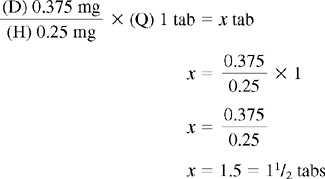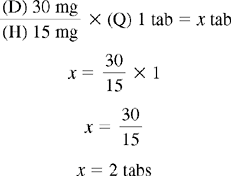CHAPTER 15 After reviewing this chapter, you should be able to: 1. Identify the information from a calculation problem to place into the formula given 2. Calculate medication dosages using the formula 3. Calculate the number of tablets or capsules to administer 4. Calculate the volume to administer for medications in solution Now that we have reviewed the terms in the formula, let’s review the steps for using the formula (Box 15-1) before beginning to calculate dosages using the formula. Now we will look at sample problems illustrating the use of the formula.
Dosage Calculation Using the Formula Method

Get Clinical Tree app for offline access
STEPS FOR USE OF THE FORMULA



 Formula Setup
Formula Setup







